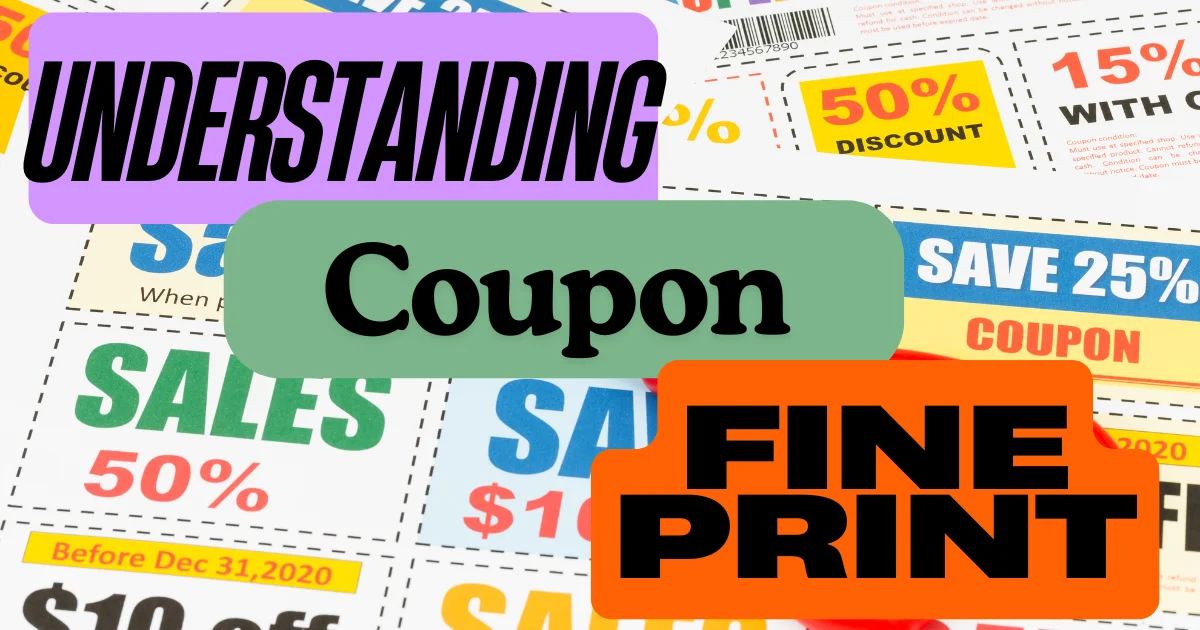How to Understand Coupon Fine Print: Secrets I Learned the Hard Way
Here are our best tips on how to read coupon fine print.

You clip that coupon or load that offer and at checkout, it’s rejected. Why? Nine times out of ten, it’s because of the coupon fine print.
Be real with me - do you ever read the fine print? Yeah, I don’t either. But the fine print on a coupon can be helpful by letting you know exactly what you can and cannot do, which in turn will help you maximize your savings and plan your shopping trips accordingly. So, it’s rather important.
I’m breaking it down for you, so that you’re armed with knowledge to make a plan to score savings!
What is on a Coupon and Why it Matters?
The fine print is probably the most detailed part of the coupon and that information helps you know exactly how to utilize the coupon correctly and even maximize your savings.
They consist of many things, each are critical pieces of information that create a blueprint of sorts for your savings.
- Eligibility restrictions: Only valid on certain SKUs, sizes, flavors, or packaging
- Date constraints: “Expires,” “Valid only between X and Y,” or “One-day use”
- Exclusion clauses: “Not valid with other offers,” “Cannot be combined with store promotions,” “Excludes clearance / sale items”
- Single use vs multi-use: Some coupons are one-time only, others reusable
- Geographic limits: Only in certain states, ZIP codes, or participating stores
- Redemption rules: Must present coupon in physical form, or scan digitally, or use the barcode printed on receipt
Let’s walk through a real-world scenario and decode the fine print together.
Example: Grocery coupon for peanut butter
Coupon reads:
“$1 off any 16 oz brand name peanut butter. Excludes deli, bakery, seafood, and multipacks. Limit one per household. Valid through 11/30/2025.”
Interpretation:
- You can’t use it on deli counter or bakery items
- You can’t use it on multipacks (so a family-size 2-pack might be excluded)
- Only one per household
- After date is useless
Coupon Limits on Usage Language
The wording on coupon limits is probably the most confusing.
If it says "Limit one coupon per purchase"
That means you can use one coupon per individual item that you're purchasing.
If it says "Limit one coupon per transaction"
That means you can only use one of these coupons per checkout. This doesn’t mean that you couldn’t still stack it with a store coupon though.
Another wording you might see is "Limit of 2 like coupons".
This means you can only use two identical coupons in one shopping trip or transaction. Sometimes it’s as many as 4, but most commonly it is 2. It’s kind of a nod from the manufacturer saying go ahead and stock up. I appreciate these!
If you see the phrase "one per person" or “one per customer”
This means you can only use one such coupon per person. And between you and me, there are ways around this one-per rule if you do encounter it but the deal is still calling your name. I’ve handed my kiddo cash and let them do a transaction. It’s a great lesson for my mini-couponer in training and I can still lock in the savings.
Trickier yet is the notation of "one per visit"
Which means you can only use one coupon per visit to the store. I’m not going to say you can’t work around it by walking out to the car and coming back, but it will likely be at the discretion of the manager. Honestly, some won’t care because it is about making a sale.
In all these cases it’s more about being in the know on the terms and using that knowledge to plan your deals out and understand where the plan might not work as you had hoped. Remember to be good natured and abide by what the store will allow.
Special Restrictions
Other fine print you need to know about is any special restrictions.
For example, free-value coupons will always note a “Not to exceed” value.
That means it will discount it up to a certain amount, but no higher. Items do come in different sizes and thus prices, so just be aware of this when choosing the item to use the coupon on. You can definitely go big and just pay the difference if you choose.
"Cannot be combined with any other coupon"
This means you can't use two manufacturer coupons on the same item. This is honestly a pretty logical assumption, but someone has tried it so now they note it just to be clear!
"Do not double"
This means even if a store doubles coupons, that coupon won't double at the checkout.
Another really sneaky notation that confuses folks is a coupon stating "Available at Walmart".
If it notes that is a “Manufacturer’s Coupon”, then it can be used at other stores too, not just Walmart. BUT, if the fine print reads "redeemable only at Target", then that means Target only, no exceptions.
Manufacturer vs. Store Coupons
The coupon should note whether it is a manufacturer or a store coupon. While both mean savings, both are handled very differently.
- A manufacturer coupon can be used at any store. You’ll usually find them in newspaper inserts, printable coupon sites, or digitally through store apps like Target.
- A store coupon is limited to a specific store. They often give you a set dollar amount or a percentage off certain items or categories.
Depending on the store, you may be able to stack a store coupon AND a manufacturer’s coupon on the same item. That’s why it’s important to understand what kind of coupon you have.
Is Digital Coupon Fine Print Different Than Paper Coupon Fine Print?
Hard question :) Sometimes. Digital coupons may omit certain restrictions or be structured differently in the system, allowing combinations or applications that a physical coupon disallows. But don’t assume always check the fine print in the app or coupon details before relying on that flexibility.
Pictures on the Coupon Can Be Deceiving
Coupons often feature a picture of an item, but just because it shows a specific item, that doesn’t mean that’s the only item it’s valid on.
Usually, it’s a higher priced or the latest version of the item that is pictured, but smaller, cheaper, or more common items still qualify too.
The picture in my opinion is just the “eye catcher”, the words on the coupon is the part that matters more.
What’s in it for the Retailer?
So, I’m a nerd at heart and I’m fascinated by how things work. There is some additional fine print on coupons that has nothing to do with us as the consumer. It does however give some insight on the retailer’s role with the coupon.
It states in some form “Retailer: We will pay you the face value plus 8¢ handling for each coupon sent to [address]”. This means that as long as the store accepts coupons according to the terms, then they will get paid when people use the coupon on a product.
New “Prohibiting” Coupon Fine Print
The times have changed as the limits have been tested. A lot of people attribute the TLC show “Extreme Couponing” as the reason for a few of fine print additions. You won’t see them on all coupons, but it is kind of shocking when you do see them.
Some coupons now note “if a product costs less than face value of coupon, consumer is not entitled to any money back.” That means no “overages” for you the coupon will be adjusted to the price of the item. And you might wonder how they would know this is happening. It all goes back to the role the retailer plays when they submit the coupon when their documentation. The company can see the transaction.
“Void if transferred, sold, auctioned, reproduced, or altered from the original” is another more common notation. This is due to the ever-growing coupon clipping websites and the fact that folks have been known to sell coupons on eBay. Though, both have gotten around this by stating that they are selling their time by clipping the coupons for you and not selling the coupon themselves. To-may-to, to-mah-to.
Have you ever been to a yard sale where it seems like they are running a drugstore? Chances are these are items that a coupon was used on to make them free or cheap and they are now reselling them. The fine print “Coupons not authorized if purchasing products for resale” has been a result of that. P&G brands almost always carry this notation now. I’m just not sure how the retailer would know this.
In all these situations, I’m not really sure what could be done. Just be aware of the fine print and cautious of these scenarios should you encounter them.
So there you have it — a cheat sheet of sorts to help you understand a coupon’s fine print better. Knowing this information will help you plan your shopping trip while avoiding any hiccups.
- Vanessa



